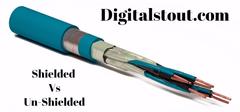Shielded Vs Un-Shielded Cables – Digitalstout takes you to basics

As a Technical Person, you are subject to this question while performing the installation of cables in an Instrument, Shielded or unshielded, the answer to this lies in certain factors, like the type of application and under what circumstance is the cable expected to provide safety from Electromagnetic interference and power frequency.
Interferences:
Interferences, a simple English definition is a trespass. In this case, the waves tend to trespass each other’s pattern, leading to an undesirable outcome, in the form of disturbance or poor output, this leading to a major loss in our commercial application.
To Give an example, let us take the case of your participation in a major music event in your area and during the course, you get to hear a lot of disturbance in the speaker system. Doesn’t it create an undesirable feeling within you and resulting in you expressing your frustration on to the organizers and in a worst case, requesting a refund. This is how a technical mistake can lead to a major financial loss.
The source of this disturbance can be natural or manmade, to give an example, take the case of lighting or sound of electrical motors respectively.
Shielded Cables:
The Shielded Cables, are standard cables, which are either paired by twisting or without but are surrounded by shielding. This is used to reduce disturbance generated from electromagnetic radiations getting generated from other instruments or any other natural disturbances.
Now the Shielding can be a layer of polymer or a tape of sheet or a braid, covered by a jacket and selection of layers and their intensity purely depends on the sensitivity of the application and the commercial aspects.
Going further, Shielding can be done in different ways, namely:
- STP: Shielded Twisted Pair.
- SSTP: Screened & Shielded Twisted Pair.
- FTP: Foil Twisted Pair.
Shielding can also be classified as:
- Braided Type: A type of shield made of braided strands of Aluminium or Copper.
- Foil Type: When the shielding is applied to individual pair or triad.
- Screen Type: When the shielding is applied to the collection of pairs.
Un-Shielded Cabes:
The Un-shielded Cable, the name says it all, yes it is a cable without any shielding and are commonly used indoor office cabling or incase the space is confined and are also commercially cheaper.
With this we sum up by saying, its important to advance your knowledge in different kinds of instrumentation cables and their compositions.







